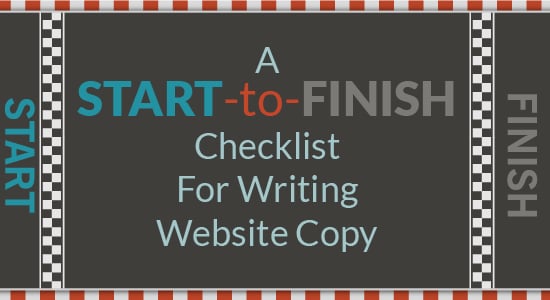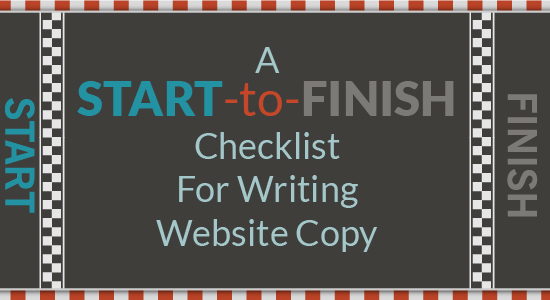A Start-to-Finish Checklist For Writing Website Copy

Website copy takes on many different forms, from product descriptions to FAQs, homepage attention-grabbers to benefits pages, and even “about us” pages. But creating the right copy for any individual page starts with following a few simple guidelines.Read on for a checklist of steps to take when crafting website copy. Whether you are the one doing the writing, and using this checklist for your own planning, or providing it as guidelines to the writers working in your department, these tips and guidelines provide a structure to ensure that copy meets expectations and is written in ways that improve website SEO and lead visitors toward the desired outcomes.
First steps in writing website copy
As with nearly every writing project for marketing and public relations, the most important steps involve understanding purpose and audience.
- Identify where on the website this copy will appear. Is it a rewrite or addition to an existing page or is it for a new page? This information will tell you whether there is an already-established template for the copy, with parameters such as word count and number or type of subheads that you need to work within.
- Identify the target audience or buyer persona(s) you are trying to reach. Each buyer persona that your marketing department has identified may have different perspectives or pain points that should be addressed in the copy. What you write for a CFO will be different than what you write to address the concerns of an IT director. If your marketing department hasn’t already defined buyer personas, these resources can help you: Create A Great Buyer Persona (blog post and downloadable sample) and Branding Mistake: Not Mapping Out Buyer Personas (problem/solution sheet download). Along with identifying who your target audience is, determine how you can make the website copy about the reader—readers care about themselves first.
- Identify which stage of the buying cycle this copy is targeting. Is this general awareness level web copy, or is it a page on the website meant to convince leads who are nearing a decision? Some website copy may also be targeted to existing customers, which would involve a different focus than that targeting leads. For greater understanding of how the stage of the buying cycle or sales funnel impacts your copywriting decisions, check these blog posts and downloadable resources: Segment Content Offers Based on Personas and the Buying Cycle (blog post), 3 Ways To Define The Customer Sales Cycle and Segment Marketing Efforts (blog post), and Content Strategy For All Stages Of The Sales Funnel (downloadable cheat sheet).
- Identify keywords or phrases that should be used for SEO purposes. While we know that SEO performance requires more than on-page keyword placement, understanding the specific keywords and phrases this piece of website copy is trying to rank for is important as the writer crafts headlines, subheads and more.
- Clarify deadlines and primary topic and list known resources for information. If you are tasked with assigning writing to others on the team and managing multiple projects, it is essential that every assignment come with clear deadlines up front to keep everyone on track. Sharing known resources with writers—whether other marketing materials or individuals who can provide information—can also speed the process and help ensure that writers are using the background material you want them to focus on. An assignment sheet template that lays out all details in the same way every time can prevent confusion. This content planning template is focused toward blog posts and downloadable offers, but could easily be modified to fit your team’s own procedures and any website copy assignment.
The website copy writing process
With the basic information about who you are writing for, where it will appear, and when the copy is due spelled out, then the actual writing can begin. The following are more guidelines than they are sequential steps; as a marketing and communication manager, you may want to create reference sheets and style guides that fit your specific website and brand to supplement these suggestions.
Headlines
- Use headlines and subheads that are 8 words or less in length.
- Include at least one target keyword or phrase in headlines and subheads.
- Make the main headline enticing to online searchers by including a benefit statement or offer.
- Check these additional blog posts for headline writing tips and best practices: How To Write Headlines That Work: Tips, Templates and Top Words, 9 Secrets To Writing Headlines, and Better Blog Titles: 6 Rules To Follow.
Main text
- Keep sentences brief and concise. For most website copy (with the possible exception of business blog posts), 30 words is a maximum. Even in longer copy like blog posts, complex sentences should be used sparingly.
- Keep paragraphs short also—5 or fewer sentences. Small chunks of text are less intimidating or off-putting to readers.
- Use subheads and numbered or bulleted lists to break up text and make it easy for readers to scan or skim.
- Write copy that answers the audience’s questions. Search engines penalize sites with “thin” low-quality content that is poorly written or fails to provide valuable information. (What constitutes high quality content? Find out here: Quality Counts When Crafting Blogs & Website Copy.)
- For product-related copy, review product information to effectively communicate features and benefits.
- When appropriate, including links from specific words or phrases to related content or offers on your website, including product pages, blog posts, how-to information or customer service access.
Call-to-action: what do you want readers to do
Every piece of text written for a website should have a purpose, and in most cases there is a direct action that you want the reader to take.
- Identify what the next step is that you want the reader to take after reading the copy. That could be to download a piece of content or a trial, request information or a consultation, subscribe to a blog or email, or go on to another page of the website.
- Tell the reader specifically in the text what that step is: “read more,” “sign up,” “buy now,” etc.
- Include links in multiple ways to allow the reader to take that step.
Before submitting copy for review
Every writer, whether new to the job or a veteran on the team, should take time for a final read-through of their own work before submitting the copy for final review.
Double check the following:
- Does the copy follow the correct format or template provided regarding text and paragraph formatting?
- Does the copy follow the assigned styleguide (e.g. AP Stylebook, Chicago Manual of Style, in-house styleguide)?
- Is the copy free of grammatical and spelling errors?
- Is a consistent verb tense used throughout the copy?
- Is the copy written in a tone that is professional yet conversational or that matches the specific voice of the brand?
- Does the copy meet the word count requirements of the assignment?
- Do all links work?
Remember that website copy is part of the overall content strategy
While this checklist of steps to follow and guidelines to remember considers each piece of website copy individually and largely from the viewpoint of the writer assigned to that specific piece of work, it is essential that all of the copy on your brand’s website be viewed in the larger scale as well. As I note in our 2020 State of Marketing: Website Strategy Report, filled with statistics gathered by our partners at HubSpot, everything about a company website, from infrastructure to content, should be developed with the needs of your customer in mind. Position your website so that it helps your prospects and customers solve their problems by providing information, while also meeting your marketing needs to convert visitors into leads and drive sales.
Your website’s copy should complement and reflect the same messaging that is being used throughout your integrated marketing and public relations strategy—from social media to blog posts, email marketing to bylined articles, videos, webinars and any other content created for both digital and traditional marketing channels.
Find more of the JONES and HubSpot perspective on website strategy in the State Of Marketing: Website Strategy Report and my companion blog post: Your Guide To Web Strategy. In the blog post, I talk about creating a strategy that addresses design or infrastructure needs, as well as content that complements the larger marketing strategy.
Ensuring that all copy written for your website is created with end goals in mind and adheres to high standards for quality writing and valuable content is essential in order to win necessary spots in search engine rankings today. If your team needs assistance in creating website copy, let’s talk about how the JONES team of experienced writers and marketers can help your company achieve its goals. Schedule a time on my calendar for a no-obligation consultation here or drop me an email today at info@jonespr.net.
-1.png?width=1652&height=294&name=Jones(RGB)-1.png)












